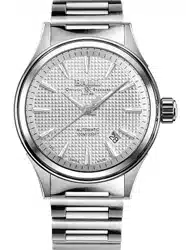Loading ...
Loading ...
Loading ...

12 13
5.3 Chronometer Certicate
All calibers that mention "-C", e.g. RR1101-C
A chronometer is an extremely accurate watch. It takes its name from
the Greek words chronos + metron meaning “to measure time”. A BALL
chronometer is a highly accurate, mechanical watch whose precision has
been tested and veried by the Ofcial Swiss Chronometer Testing Institute
(Contrôle Ofciel Suisse des Chronomètres, or COSC, in French).
Before issuing the certicate, the COSC conducts elaborate precision tests
on each BALL movement using cameras and computers and analyzes the
data. The COSC performs seven different tests. Failure to meet the minimum
standard in any one of the tests means that a movement is rejected. Here is
a brief summary of the testing procedures:
※ Test 1
Mean daily rate: After 10 days of tests, the mean daily rate of the movement
must be within the range of -4 to +6 seconds per day. The COSC determines
the mean daily rate by subtracting the time indicated by the movement 24
hours earlier from the time indicated on the day of observation.
※ Test 2
Mean variation in rates: The COSC observes the movement rate in ve
different positions (two horizontal, three vertical) each day over 10 days for
a total of 50 rates. The mean variation in rates can’t be more than 2 seconds.
※ Test 3
Greatest variation in rates: The greatest of the ve variations in rates in
the ve positions can’t be more than 5 seconds per day.
※ Test 4
Horizontal and vertical difference: The COSC subtracts the average of
the rates in the vertical position (on the rst and second days) from the
average of the rates in the horizontal position (on the ninth and tenth days).
The difference must be no more than -6 to +8 seconds.
※ Test 5
Greatest deviation in rates: The difference between the greatest daily
rate and the mean daily test rate can’t be more than 10 seconds per day.
※ Test 6
Rate variation due to the temperature: The COSC tests the movement’s rate
at 8 degrees Celsius (46 degrees Fahrenheit) and at 38 degrees Celsius (100
degrees Fahrenheit). It subtracts the cold temperature rate from the hot
temperature rate and divides by 30. The variation must be no more than
0.6 seconds per day.
※ Test 7
Resumption of the rate: This result is obtained by subtracting the average
mean daily rate of the rst two days of testing from the mean daily rate
of the last test day. The resumption of rate can’t be more than 5 seconds.
ENGLISH
Loading ...
Loading ...
Loading ...
